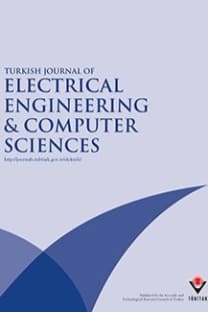Low-cost sliding mode control of WECS based on DFIG with stability analysis
Doubly fed induction generator, robustness and stability, sliding mode control, rotor current sensorless, wind energy conversion system
Low-cost sliding mode control of WECS based on DFIG with stability analysis
Doubly fed induction generator, robustness and stability, sliding mode control, rotor current sensorless, wind energy conversion system,
___
- Mohammadi J, Vaez-Zadeh S, Afsharnia S, Daryabeigi E. A combined vector and direct power control for DFIG- based wind turbines. IEEE T Sustain Energ 2014; 5: 767–775.
- Shuhui L, Haskew TA, Williams KA, Swatloski RP. Control of DFIG wind turbine with direct-current vector control configuration. IEEE T Sustain Energ 2012; 3: 1–11.
- Liyan Q, Wei Q. Constant power control of DFIG wind turbines with super capacitor energy storage. IEEE T Ind Appl 2011; 47: 359–367.
- Belmokhtar K, Doumbia ML, Agbossou K. Novel fuzzy logic based sensor-less maximum power point tracking strategy for wind turbine systems driven DFIG (doubly-fed induction generator). Energy 2014; 76: 679–693.
- Beltran B, Benbouzid MEH, Ahmed-Ali T. Second-order sliding mode control of a doubly fed induction generator driven wind turbine. IEEE T Energy Conver 2012; 27: 261–269.
- Yu Z, Elbuluk ME. Stability analysis of maximum power point tracking (MPPT) method in wind power systems. IEEE T Ind Appl 2013; 49: 1129–1136.
- Jiabing H, Yikang H, Lie X. Improved rotor current control of wind turbine driven doubly-fed induction generators during network voltage unbalance. Electr Pow Syst Res 2010; 80: 847–856.
- Chen SZ, Cheung NC, Wong KC, Wu J. Integral variable structure direct torque control of doubly fed induction generator. IET Renew Power Gen 2011; 5: 18–25.
- Chen SZ, Cheung NC, Wong KC, Wu J. Integral sliding-mode direct torque control of doubly-fed induction generators under unbalanced grid voltage. IEEE T Energy Conver 2010; 25: 356–368.
- Martinez MI, Tapia G, Susperregui A, Camblong H. Sliding-mode control for DFIG rotor- and grid-side converters under unbalanced and harmonically distorted grid voltage. IEEE T Energy Conver 2012; 27: 328–339.
- Hua G, Cong L, Geng Y. LVRT capability of DFIG-based WECS under asymmetrical grid fault condition. IEEE T Ind Electron 2013; 60: 2495–2509.
- Nian H, Cheng P, Zhu ZQ. Independent operation of DFIG-based WECS using resonant feedback compensators under unbalanced grid voltage conditions. IEEE T Power Electr 2014; 99: 1–12.
- Rezaei E, Tabesh A, Ebrahimi M. Dynamic model and control of DFIG wind energy systems based on power transfer matrix. IEEE T Power Deliver 2012; 27: 1485–1493.
- Hu J, Nian H, Hu B, He Y, Zhu ZQ. Direct active and reactive power regulation of DFIG using sliding-mode control approach. IEEE T Energy Conver 2010; 25: 1028–1039.
- Abad G, Rodriguez MA, Poza J. Two-level VSC-based predictive direct power control of the doubly fed induction machine with reduced power ripple at low constant switching frequency. IEEE T Energy Conver 2008; 23: 570–580.
- Abad G, Rodriguez MA, Poza J. Two-level VSC-based predictive torque control of the doubly fed induction machine with reduced torque and flux ripples at low constant switching frequency. IEEE T Power Electr 2008; 23: 1050–1061.
- Susperregui A, Martinez MI, Zubia I, Tapia G. Design and tuning of fixed-switching-frequency second-order sliding- mode controller for doubly fed induction generator power control. IET Electr Power Appl 2012; 6: 696–706.
- Evangelista C, Puleston P, Valenciaga F, Fridman LM. Lyapunov-designed super-twisting sliding mode control for wind energy conversion optimization. IEEE T Ind Electron 2013; 60: 538–548.
- Slotin JJE. Sliding controller design for non-linear systems. Int J Control 1984; 43: 421–434.
- ISSN: 1300-0632
- Yayın Aralığı: Yılda 6 Sayı
- Yayıncı: TÜBİTAK
Performance improvement of three-phase self-excited induction generator feeding induction motor load
JYOTIRMAYEE DALEI, KANUNGO BARADA MOHANTY
Optimal integration of hybrid (wind--solar) system with diesel power plant \newline using HOMER
Muhammad Noman SIDDIQUE, Aftab AHMAD, Muhammad Kashif NAWAZ, Syed Basit Ali BUKHARI
Mahalakshmi MAHADEVAN, Latha SALAI
Juan ZHOU, Malong LIU, Chen WEI, Chaoxu GAO, XIAOJIE WU
Group control and identification of residential appliances using a nonintrusive method
Sunil SEMWAL, Munendra SINGH, Rai Sachindra PRASAD
Amorphous core transformers efficiency analysis in Turkish electrical distribution systems
Capacity allocation of hybrid solar-wind energy system based on discrete probabilistic method
Preface - Special Issue on: 'Advances in renewable energy and energy efficiency technologies'
